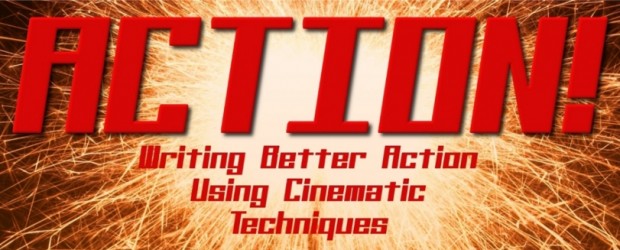The Fight
or, “Two Men Enter, One Man Leaves.”
A physical contest between two individuals is probably the oldest kind of conflict in human evolution, and forms the cornerstone of all action. In any violent conflict, if you strip away all the weapons, gadgetry, vehicles, costumes, etc., you’re left with two naked savages trying to overpower each other with brute strength. It sounds uncivilized, because it is.
Fights can be broken down into three sub-categories: Mano a Mano, the Gang-Up, and the Brawl.
Mano a Mano, Spanish for hand-to-hand, represents the most basic of all action scenes: two characters fighting in close quarters. This kind of fight can be unarmed, meaning the only weapons the characters use will be their own bodies—like a martial arts duel with punching and kicking—or with melee weapons of any sort. Little John and Robin Hood dueling with quarterstaves on a log bridge is a Mano a Mano fight. So is the lightsaber battle between Darth Vader and Obi-Wan Kenobi in Star Wars.
When writing a Mano a Mano scene, the narrative can follow one character, either in first-person, third-person close Point of View (POV), or third-person omniscient. The main kinds of Stunts that will occur in a Mano a Mano scene are:
- Flurries of punches, kicks, slaps, or use of melee weapons,
- Throwing opponents against, onto, or through parts of the set,
- Wrestling and grappling,
- Using pieces of the set as improvised weaponry, especially when no other weapons are available, and
- Falling, because fighting is treacherous even on flat, solid ground, and most fights aren’t going to take place in the best terrain.
A Mano a Mano scene ends when one character dies, surrenders, or runs away. This last may lead to another kind of action scene which will be discussed later: The Chase.
The Gang-Up is similar to Mano a Mano, but instead involves one character or a small group fighting with a much larger group. In a Gang-Up, sides may be intentionally balanced for dramatic purposes, or the underdog may have weapons, abilities, or in some other way be a match for the larger force. This is most often the case in fiction because in reality, an underdog faced with a vastly superior force is going to wind up so much chum.
Narration in Gang-Ups requires careful planning to avoid headhopping, which is the bane of all fiction and especially the action scene. If you are using a first-person or third-person close POV, you must take extra care not to narrate things that the POV character cannot know. For example, if your hero is battling three enemy swordsmen on a staircase in a castle, he can’t know that one of his allies is perched on an adjoining tower, preparing to cast a fireball spell through a window. All he’ll know is that a blast of flame comes into the stairwell and incinerates the enemy soldiers. He may be able to draw a conclusion as to what happened, but he can’t know for certain if the narrative is only following him. You may find an omniscient viewpoint is easier when writing a fight of this type.
Stunts in a Gang-Up will be essentially the same as those used in Mano a Mano, and the scene will end when one side dies, surrenders, or escapes.
The Brawl is the most difficult type of fight to write. It is a fight between two large groups or a free-for-all between numerous characters with no clear sides. The difficulty in constructing a Brawl in fiction is how to narrate it. Most writers automatically pull back to use a third-person omniscient narrative, but in reality, that isn’t usually the best choice. The problem with third-person omniscient in this case is that there are far too many characters to keep track of. When writers try to do so, they wind up bogging down the action and interfering with the reader’s association with the narrative focal characters. It also creates a “Dispassionate Distance,” which makes injuries and deaths meaningless to the reader. Remember, your stories are about people (or should be), not about events. A huge fight may be a grandiose spectacle to behold, but the reader wants to know first and foremost what happens to the Hero.
When writing a Brawl, consider approaching it using a third-person close or first person narrative, and make sure you keep the focus upon what the character can see/hear/otherwise experience with his or her senses. Imagine the confusion of trying to write a bar fight with twenty different characters, four of which are the Heroes. Now approach that same scene but keep the camera on just one character. She may be aware of what’s happening off to one side, but she won’t see the big guy sneaking up behind her, until one of her allies clocks him with a beer mug and he hits the floor beside her.
